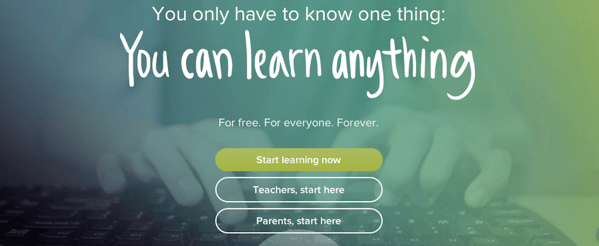
Inbound Marketing for Edtech: What to Keep & What to Throw Away
April 28, 2015
By Amber Kemmis
The move from print to digital, like in many industries, is very evident in education. As the infographic below shows, not only is there an increase in education technology as a result of more digital minded students, but technology in education is also growing to modify the education system to accommodate those who need learning tools and systems that deviate from traditional classroom learning.
If you are one of the companies already taking advantage of the opportunity that exists in education technology, what is your strategy for reaching potential customers? Is it working? With an 11% growth in spend from 2013 to 2014 and a projected market grow of over $19 billion by 2018, now is a good time to develop a sound marketing strategy that ensures your company is able to claim a portion of that market and ultimately improve education as your company grows.
Inbound Marketing for Edtech
Just as technology has shaped education, it has also shaped the way marketers must reach their customers. A sound marketing strategy no longer consists of expensive trade shows and conferences, cold calls, ads, and direct mail. With technology and a digital world, customers can tune out these invasive and interruptive marketing campaigns. For companies that want to grow business and revolutionize learning as the edtech market grows, inbound marketing, not outbound marketing will generate the best results.
Although almost 60% of marketers have adopted inbound marketing strategies, the edtech world is still somewhat slow to adopt this approach. Inbound marketing, as mentioned above, does not seek out customers like traditional, outbound marketing methods. Instead, inbound marketing attracts customers through the use of educational and valuable content that helps move the customer closer to purchase and further down the funnel. While inbound marketing encompasses multiple, interrelated components including websites, SEO, blogging, lead generating content offers, email, lead nurturing, and much more, there are some things that should be emphasized in edtech marketing and some that can be forgotten.
What to Keep
Personas & Targeted Content
Trying to reach customers can be challenging in education, especially when targeting decision makers at the K-12 level where the buying process is complex and involves a multi-level approval process, RFPs, and detailed contracts. Fortunately, inbound marketing is effective despite this unorthodox sale because it emphasizes the importance of marketing centered on a buyer persona. While you should keep this aspect of inbound marketing for edtech, buyer personas in edtech need to be thought out a bit differently depending on who makes the purchasing decision. For example, technology that will be used in the classroom needs to gain buy-in from students, teachers, school administrators, and most likely, a school board or district officials. On the other hand, an at-home technology that aids with homework may simply involve the student and parent. Thus, it is important to consider your target buyer and any important stakeholders that will be involved along the way.
While students, teachers, district officials, and administration share the same goals, they each play into the decision differently and have different considerations when making a decision. The content you produce should take this into consideration and create content to the user, stakeholder, and purchaser. Target those teachers who will be early adopters and advocates (for every teacher, there are 3-5 more teacher friends to share your brand’s story with) with content that provides value, so that they spread awareness about your brand. Do this for students and parents too. However, always keep in mind that you will also need to create content for school officials that help to gain approval.
Blogging
With search engines being one of the most utilized tools in finding solutions to problems, SEO is critical to helping you reach your audience at their moment of need. While your website, which is typically centered around your product, can help gain some traction for SEO, blogging will have a much bigger impact for multiple reasons. First, blogs should provide content that is non-invasive and educational, so visitors are more likely to engage and find you even when they aren’t searching for your specific product. Second, blogging allows you to keep content fresh and growing for future points of contact. While blogging may not help you reach the decision maker, it will help you to reach users and your potential brand advocates.
Social Media
In edtech or any industry for that matter, you have to go to where the customers are. While sales may not be able to stop in for a face-to-face at a school, your company can still be where users and advocates are using social media. And, just in case you thought otherwise, let me emphasize that 80% of K-12 teachers use social media personally and professionally. Instagram, Facebook, Pinterest, Twitter, and even LinkedIn are valuable tools in promoting your educational content and engaging teachers, parents, students, and school officials.
Segmentation
A one-size fits all approach doesn’t work, and inbound marketers know that, which is why segmentation is one tactic you’ll want to ensure you include in edtech marketing. From your website to email campaigns, it is critical to help segment so that the individual receives only relevant messages and has a unique experience as they interact with your brand. For example, one way that Khan Academy segments is with a click-through path for parents or teachers (see below).
What to Throw Away
Top to Bottom Buying Cycle
Inbound marketing places a big emphasis on the buying cycle and moving a lead through the funnel. However, as mentioned previously, the complex buying cycle typical in education means that a lead won’t move through the funnel from top to bottom. For example, a teacher may come to your website and fill out a form to become a lead, but the teacher won’t be the one making the buying decision, so it doesn’t make sense to move the teacher through the funnel as you typically would through lead nurturing.
Lead Nurturing
Similarly related to the buying cycle is lead nurturing. Lead nurturing, for those unfamiliar, is the use of email workflows and content to move a lead through the funnel to ultimately close a sale. Now, let me first clarify that this doesn’t mean you should completely abandon lead nurturing campaigns. They can help keep your audience engaged, help segment to identify decision makers, and if you do have leads who are involved in decision making already in your funnel, they can help provide them with the content they need to convince other stakeholders involved.
With that said, lead nurturing shouldn’t be put in place just because of its importance in inbound marketing for other industries. Start by identifying the goal of the lead nurture campaign, ensure it aligns to the unorthodox buying cycle in the school setting, and don’t hold unrealistic explanations. Lead nurturing only allows you to reach your audience through email, so you can’t expect it to work in a linear fashion when your nurturing the teacher and the ultimate decision maker isn’t in your contact database. At some point, you’ll need some legs on the ground to work with decion makers and contact outside of email.
Getting Started with Inbound
The most important thing to remember with inbound is that you are reaching the customer based on their wants and needs. In edtech, what your customer needs and wants could vary significantly depending on the type of technology you sell. If your company is convinced that inbound marketing is the way to reach your customers, the first step to getting started is to learn about your buyer and the journey that occurs on their way to purchase. From there, you can building an inbound marketing strategy that aligns to each step of that journey. Get started with this process today by requesting a consultation the SmartBug team.
About the author
Amber Kemmis was formerly the VP of Client Services at SmartBug Media. Having a psychology background in the marketing world has its perks, especially with inbound marketing. My past studies in human behavior and psychology have led me to strongly believe that traditional ad marketing only turns prospects away, and advertising spend never puts the right message in front of the right person at the right time. Thus, resulting in wasted marketing efforts and investment. I'm determined to help each and every one of our clients attract and retain new customers in a delightful and helpful way that leads to sustainable revenue growth. Read more articles by Amber Kemmis.









